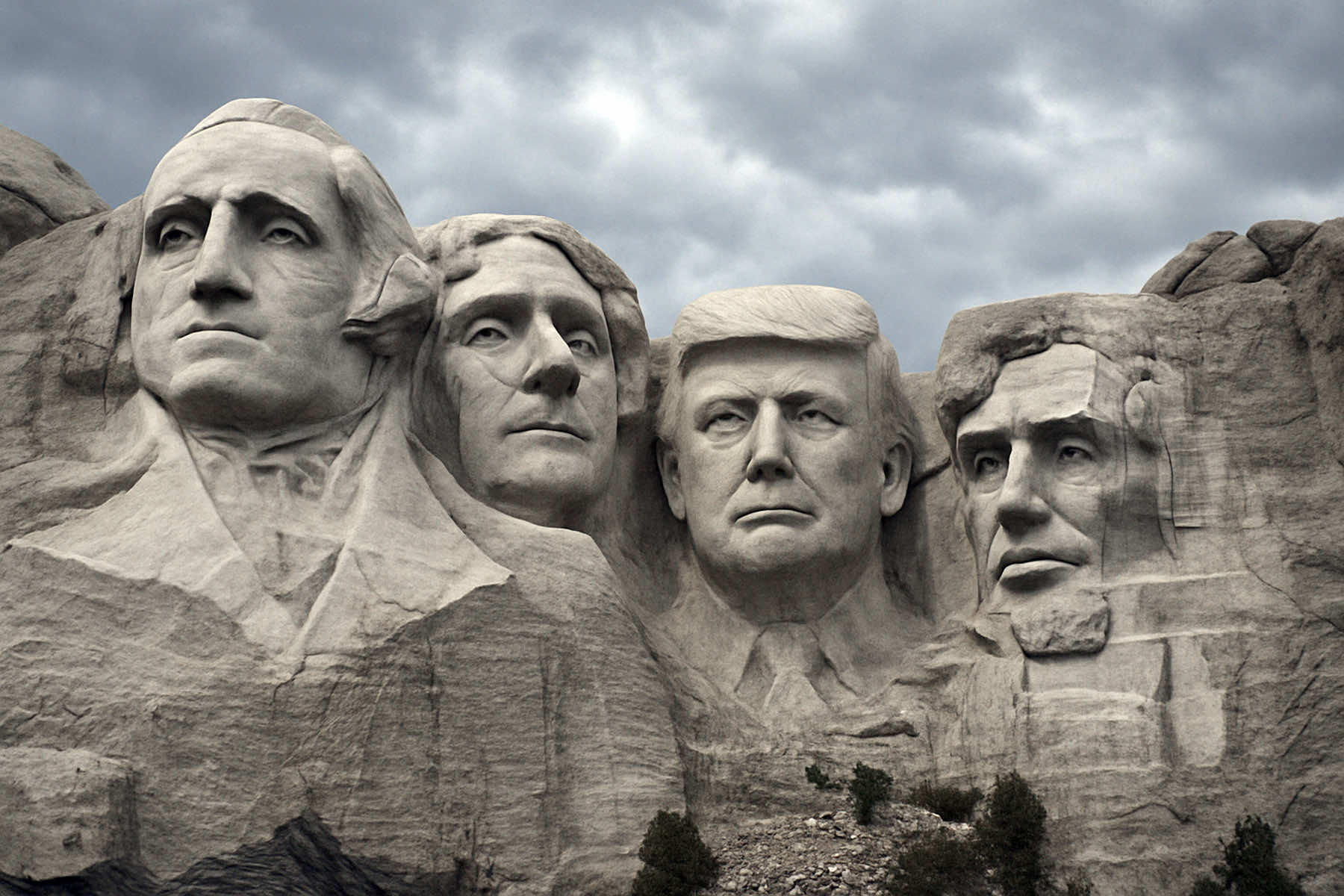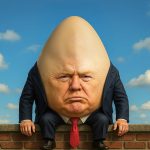
This AI-generated image is a photorealistic editorial illustration and not an actual photograph. It was created to support a journalistic commentary as a political cartoon.
The face Donald Trump most wants carved into stone is his own. That is not political commentary, it is the visible core of a pattern that blends psychological compulsion, political ambition, and systemic destabilization.
Trump’s repeatedly stated desire to have his likeness added to Mount Rushmore is more than an idle boast. It is a symbol of a deeper drive: to project himself into the pantheon of American greatness by force of will, not earned legacy.
That desire, repeatedly stated in rallies, media appearances, and private exchanges with officials, mirrors a pattern of behavior built on theatrical domination of national imagery and legal boundaries.
And it aligns with three psychological profiles routinely examined in political psychology: narcissistic personality traits, authoritarian mindset, and the instrumental use of fear — traits that, when taken together, reflect a deeper psychological need for control, symbolic dominance, and permanent visibility within the national identity.
Trump’s Mount Rushmore fixation can be understood as a literal manifestation of grandiosity. His interest is not symbolic patriotism, but visual immortality. To be sculpted alongside Washington and Lincoln, not because he preserved democracy, but because he conquered its institutions and ruled in defiance of them. This is not reverence for history. It is the assertion that history should be rewritten to accommodate him.
Narcissistic grandiosity is defined by an obsession with recognition and domination of narrative. Trump’s tenure in office has been marked by repeated attempts to displace shared history with personal mythology — from rebranding policy efforts with his name, to demanding loyalty oaths, to refusing any acknowledgment of electoral defeat. Mount Rushmore is simply the physical endpoint of a psychology that cannot tolerate transience or accountability.
The second trait at play is authoritarian symbolism. In regimes around the world, authoritarian leaders seek permanence through architecture, sculpture, and national myth. Trump’s public performances have drawn on this mode. He has staged events against monumental backdrops, invoked military force against dissent, and treated the White House as a personal estate rather than a temporary civic trust. The dream of joining Mount Rushmore is coherent within this mindset: it is the conquest of national myth through spectacle and repetition.
But there is a third dimension that makes this more dangerous than theatrical narcissism. It is the calculated use of spectacle and fear to control public perception. Trump has demonstrated a repeated reliance on intimidation, symbolic projection, and institutional defiance — all deployed to elevate personal myth over democratic accountability. The Mount Rushmore fixation is not an isolated fantasy but a reflection of this pattern: to dominate not only political opponents, but the national imagination itself.
This is not merely about vanity. The projection of personal power into national monuments is part of a larger strategy: to replace collective civic memory with an image of the leader as eternal, unchallengeable, and central to the nation’s very identity. It recasts governance as a stage for self-glorification.
Trump’s efforts to link himself to Mount Rushmore cannot be dismissed as harmless vanity. They reflect a persistent attempt to equate personal dominance with national legitimacy. The mountain he wants to join was not built by those who glorified themselves, but by those who submitted their power to constitutional boundaries. In contrast, Trump’s political life has been defined by the rejection of those boundaries and the elevation of personal image above institutional responsibility.
The desire to appear on Mount Rushmore is not just about legacy. It is about rewriting the canon of American power. To be carved in stone is to be permanent. It signals that democratic review of elections, law, and accountability has no further claim. In Trump’s mind, the monument is not a place of earned reverence but a battlefield to be conquered.
Stone Mountain in Georgia offers a stark precedent: a monument carved not to celebrate national unity, but to enshrine the mythology of the Confederacy. The massive relief of Jefferson Davis, Robert E. Lee, and Stonewall Jackson was commissioned not in the aftermath of the Civil War, but during the 20th century as a deliberate act of cultural revisionism.
It was meant to legitimize a treasonous legacy by granting it permanence, to elevate the defenders of slavery into the granite of national memory. Like all monumental propaganda, it was not built to remember history, but to reshape it.
The desire to join Mount Rushmore is not about history — it is about control. The act of permanently embedding oneself into the national monument is symbolic of a deeper compulsion to dominate the national narrative, erase institutional limits, and immortalize personal power as foundational. It is not governance through service, but governance through spectacle.
Trump’s desire to be etched alongside foundational presidents reflects a drive not only for legitimacy but for unquestioned centrality in American identity. The messaging around this ambition often blurs the line between public service and personal worship, transforming political support into symbolic loyalty. That loyalty is reinforced not through shared policy goals, but through spectacle, grievance, and the repeated performance of power.
The Mount Rushmore fantasy places him physically above the nation — a figure of granite, above time, above law. But the path to that fantasy is paved with institutional sabotage. Trump’s attempts to override state certification processes, replace electors, discredit the judiciary, and delegitimize federal investigators form a cohesive pattern. In isolation, these are legal challenges or political theater. In aggregate, they represent a strategic assault on constitutional continuity.
Understanding Trump’s psychological motivations is not academic indulgence. It is essential to explain why his fixation on permanence — through stone, pageantry, or rewritten history — poses a unique challenge to democratic culture. His behavior follows a pattern of grievance, elevation, and mythmaking, all in pursuit of a legacy that defies checks, terms, or boundaries.
The American system was not designed to prevent a president from desiring monuments. But it was designed to restrain those who conflate personal permanence with national identity, especially when they use destabilizing force to pursue it.
Trump’s Mount Rushmore obsession is not dangerous because it is narcissistic. It is dangerous because it is consistent with the operational methods of political extremism that seek to replace governance with loyalty and rewrite law with spectacle.
That is not ambition. That is authoritarian mimicry. And no mountain should bear its likeness.
This AI-generated image is a photorealistic editorial illustration. It is not an actual photograph and does not depict a real situation. The image was created to support commentary protected under the First Amendment of the U.S. Constitution as a form of political expression. Its use is consistent with established legal precedent, including the Supreme Court’s decision in Hustler Magazine, Inc. v. Falwell, 485 U.S. 46 (1988), which affirmed that satire and parody involving public figures are protected forms of speech and are not considered defamation unless containing knowingly false factual assertions made with actual malice.
ChatGPT-4o













